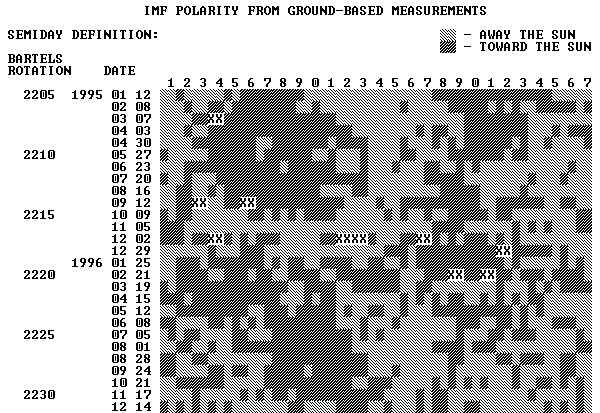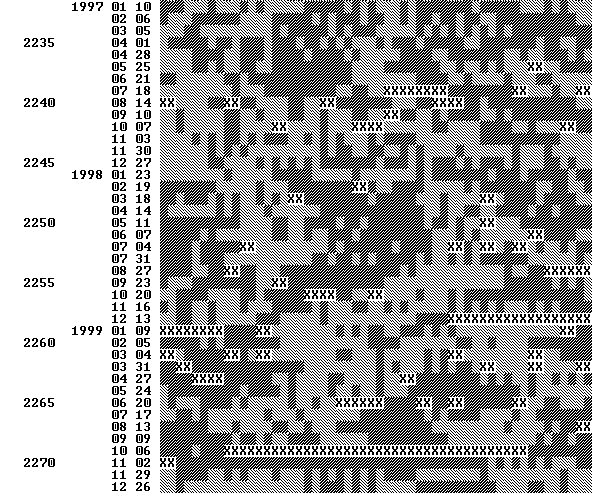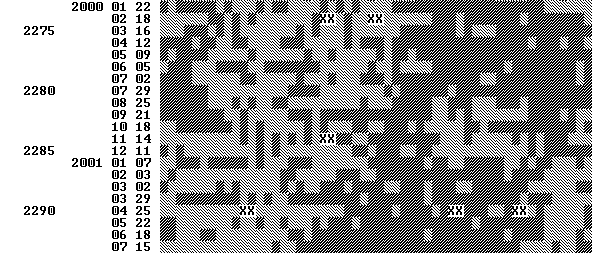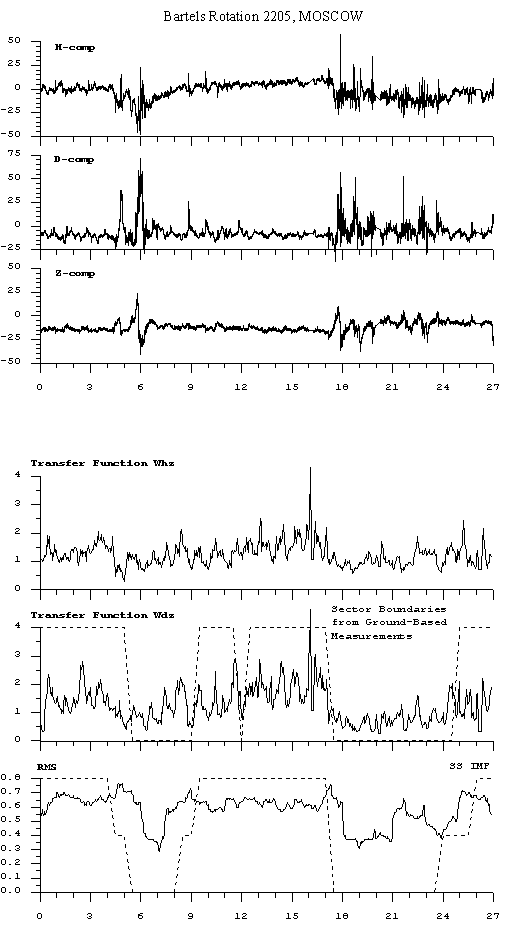


Determination of the sector structure of IMF from ground-based data:
recent results and usage prospects.
A. N. Zaitzev (1), V. I. Odintsov (1),
L. Trichtchenko (2), D. H. Boteler (2), R.L. Coles (2)
(1) - IZMIRAN, Troitsk, Moscow region, RUSSIA
(2) - Natural Resources, Ottawa, CANADA
Abstract.
The determination of sector structure of IMF (SS IMF) was continued on the base of data from pair of magnetic observatories Vostok - Resolute Bay. Now the SS IMF in the form of standard table for period of January 1957 to July 2001 is displayed on the http://www.izmiran.ru/stp/polar/SSIMF/index.shtml. Now the determination is performed by semiautomatic method based on previous results and new improvements. We make some modifications into the basic technique of SS IMF definition that greatly improves the performance and reliability of results.
We consider our method as the most reliable data source for magnetospheric research as it already includes results of interaction of SS IMF with the Earth magnetic field. Moreover we make attempt to infer the SS IMF from data of Moscow magnetic observatory. The analysis of data for period of solar activity minimum at 1995 confirmed that in the toward sector (By < 0, Bx > 0) geomagnetic activity dominates in comparison with the away sector (By > 0, Bx < 0). Usually in the toward sector we observe Bz < 0. Large scale spatial variations and evolution of SS IMF in connection with the general development of solar activity and dynamics of the heliospheric current sheet in the maximum of solar cycle 23 are discussed. We also analyze the usage prospects of our data in view of similar information obtained from ACE satellite and ground solar observatories.
The work was partially supported by the Russian Fund of Basic Research, RFBR grant 00-07-90206.
Introduction.
The connection of the interplanetary magnetic field polarity with geomagnetic agitation in the polar caps is well known and named as Svalgaard-Mansurov effect. After its discovery and detailed studies become evident that main cause of such effect is the variations of By component of IMF performed by the large-scale entry process. During such process we have the reconnection of IMF with cusp region field lines and solar wind plasma entering to the cusp regions. The topology of main solar magnetic field includes the two sectors (toward and away) separated by heliospheric current sheet. The changes in the sector structure of IMF (SS IMF) are used for correlation studies as well as the basic (reaper) point in the prediction service. Although nowadays we have direct “in situ” the solar wind parameters and the solar magnetic field observations on the regular base, the only one ground-based observations of terrestrial magnetic field might confirm what is happening in the real interaction process of solar wind with magnetosphere. So every study of solar wind – magnetosphere interaction, which is based on geomagnetic observations, still in use and demand for case and statistical studies. That is why the regular data as SS IMF according the Vostok-Resolute Bay pair of stations are widely used in scientific literature.
Experimental results.
In this paper we present the latest results of SS IMF definitions as we produce according data from Resolute Bay station. The data from Vostok station was not available for a long time due to failure of station and now we not use it, although we plan to search Vostok data in nearest future to restore the source of SS IMF in Southern Hemisphere.
Due to recent direct observations of the solar wind parameters on WIND, ACE, Interball satellites it is appears a new possibility to search the detailed structures of SS IMF and how its displayed in the geomagnetic and magnetospheric activity. The sector structure of IMF (SS IMF) is rather variable feature and can be described in a few patterns as we assume: soft, regular pattern duration more than one day; sharp, shock-type pattern with duration less than one day and irregular pattern with prolonged period of unsettle sign of By-component. In addition to regular features of solar wind as SS IMF display it we must pay attention to the magnetic clouds and interplanetary shocks in connection with magnetic storms which are overlapped on the regular SS IMF. According our point of view in our table we have mostly the clear manifestation of a regular pattern in the position of heliospheric current sheet. The irregular features also presented but can not be adequately compared/connected with solar wind data.
On Fig.1 we display the table of sector structure of interplanetary magnetic field (SS IMF) for the period 1995-2001 as inferred from Resolute Bay magnetic observatory.



Fig. 1. The sector structure of IMF for the period 1995-2001 as inferred from Resolute Bay magnetic observatory.
The main features in the dynamics of SS IMF were as follows. In the period of 1995-1996 we have the minimum of solar activity so the table present the two-stream, four-sector structure of IMF. The interval of Bartels rotations 2204-2211 was analyzed in paper (1) in attempt to compare with direct WIND measurements. The beginning of 23-rd solar activity circle was counted from the May, 1996 (BR 2223) when we observe two sector structure which correspond to the simple configuration in the solar wind with flat position of heliospheric current sheet (HCS). As circle was developed we see the changes in the SS IMF i.e. the SS IMF again become in the four-sector pattern. That is happened already on growing phase in second part of 1997. We also observe the steady drift of general SS IMF pattern regarding the solar surface till the moment of change the sign in main magnetic field of the Sun. Such change was observed at the BR 2283-2285, although optical observations of the Sun display the changes in the sign from June 2000. So after this interval the HCS divide main solar field in the pattern where we have above HCS the sector toward the Sun, negative By, and bottom of HCS we have the sector away the Sun, positive By. For that period of time in the table Fig.1 we have simple two-sector structure, which correspond the position of HCL almost perpendicular to ecliptic plane, BR 2290-2293.
In view the importance of SS IMF data for continuous monitoring of solar wind parameters for space weather services we make attempt to infer the SS IMF from the data of magnetic observatories located in middle latitudes. The motivation for such move we find from simple comparison of magnetograms with SS IMF tables as we get for 1995. To be sure that our definitions based on analytical method we used the procedure which we develop for correlative studies between magnetic field components in the problem of magnetotelluric monitoring of geodynamic processes (8). The main feature was in the use of adaptive filtering of data.
On Fig.2 we present the data of Moscow magnetic observatory (upper part) and results of adaptive filtering in the combination of the components H - Z and D - Z.

Fig. 2. The top – Moscow original geomagnetic data, bottom – the processed data according (8), which display the sector structure of IMF (dotted line).
The difference in the transfer function modes is presented at bottom line. The SS IMF for BR 2205 was taken from (1). Simple comparison confirm the good correspondence between changes observed in magnetic field variations in Moscow magnetic observatory inferred by the cross-correlation after adaptive filtering and SS IMF values.
On Fig.3 we present the SS IMF data for interval of BR 2205-2210.


Fig. 3. The sector structure of IMF for Bartels rotations 2204 – 2210 as inferred from Resolute Bay magnetic observatory (top) and Moscow magnetic observatory (bottom).
The upper part is the standard data according the Resolute Bay; the lover part is the SS IMF as we get from Moscow magnetic observatory. The general features of both graphs are very close each other. The differences might be in the range of accuracy of calculations.
Discussion.
The tables of SS IMF according ground-based data display the results of real interaction of the solar wind with the magnetosphere. Nowadays we have tremendous progress in outer space observations when we have the continuous parameters of solar wind at ACE satellite including sector structure of IMF. In addition to that solar observatories as WSO (Wilcox (Stanford) Solar Observatory, NSO (Kitt Peak Solar Observatory), MWO (Mount Wilson Solar Observatory) provide the solar magnetic field data which used to calculate the "source surface" field in the form of space maps. Such maps clear demonstrate what we might expect in the vicinity of Earth. The analysis of such complex data will lead to the good prediction of solar wind speed, IMF polarity and Kp-index (4).
The role of SS IMF as the "reaper" point for the magnetosphere studies was confirmed many times. The detailed research of polar cusp dynamics lead to conclusion that interplanetary magnetic field azimuthal component (By component in SS IMF) is the critical value in the polar cusp configuration (2), every sector structure lead to the forcing of substorm activity during the passage of an interplanetary magnetic cloud (3), and SS IMF regular structure displayed as the seasonal effects in the location of auroral substorm onset (5) and in the global auroral pattern (6). This samples clearly confirm the importance of SS IMF as the scientific fact and that lead to usage of SS IMF for space weather services, see paper (4) where discussed the improvements in the prediction of solar wind conditions using near-real time solar magnetic field updates i.e. SS IMF.
The further improvements in the definition of the SS IMF tables we connect with our new method to see the forcing due to sector structure in the middle latitudes as we demonstrate for the Moscow observatory. Same interval was processed for Kakioka magnetic observatory and we get the same results. Main clue is lie in the comparative studied of satellite and ground-based observations. As obvious points we see the next scientific tasks. According ACE data is possible to infer the regular (large-scale) structure of IMF (as it already done in Japan, see http://www.crl.go.jp/uk/uk223/service/27day/index.html) and compare it with the table already inferred from ground-based data, and to estimate the long-range changes in solar wind dynamics. Next the search of fine structure of sector boundary (heliospheric current sheet) as its displayed on the high-latitude magnetogrammes, first of all on the Resolute Bay / Vostok stations and according special network MACCS (Magnetometer Array for Cusp and Cleft Studies) which data available from Augsburg College via Internet. Such studies cal help to understood some changes in the structure of sector boundary on the short distances as 250 Re according ACE and Interball satellites data.
In view of that the further definitions of SS IMF might be based on the 3 levels as data sources: observations of magnetic field of Sun, solar wind data from L 1, and continuos data from magnetic observatories in polar caps. The differences in the data sets arise first of all due to differences in the accuracy of observational methods. The calculations of heliospheric magnetic field distribution strongly depend on the fidelity of data. We have 3 observatories, which provide continuos data: WSO, NSO, and MWO. The accuracy of calculations for the position of SS IMF can exceed plus/minus one day, see http://solar.sec.noaa.gov.
Conclusions.
The definition of SS IMF based on pair of stations Vostok-Resolute Bay served as the primary source of solar wind parameters, which display direct interaction with the magnetosphere.
The data set of 1995-2001 display all general features of 23 solar circle and its dynamical features confirm the peculiarities as we observed in previous solar circles. The reverse of polarity for main magnetic field of the Sun was observed in SS IMF with small delay relatively optical observations and corresponds to the maximum of solar activity.
The influence of SS IMF on general state of Earth's magnetic activity can be found in the data of all magnetic observatories, including middle latitudes. This fact can be used to detect SS IMF according data of Moscow observatory.
References.
Candidi M., G. Mastrantonio, S. Orsini, C.-I. Meng, Evidence of the influence of the Interplanetary magnetic field azimuthal component on polar cusp configuration, J. Geoph. Res., vol.94, no.A10, pp. 13585-13591, 1989.
Farruga C. J., M. P. Freeman, L. F. Burlaga et al., The Earth's Magnetosphere under continued forcing: substorm activity during the passage of an interplanetary magnetic cloud, J. Geoph. Res., vol.98, no.A5, pp. 7657-7671, 1993.
Arge C. N., V. J. Pizzo, Improvements in the prediction of solar wind conditions using near real-time solar magnetic field updates, J. Geoph. Res., vol.105, no.A5, pp. 10465-10479, 2000.
Liou K., P. T. Newell, D. G. Sibeck, et al., Observation of IMF and seasonal effects in the location of auroral substorm onset, J. Geoph. Res., vol.106, no.A4, pp. 5799-5810, 2001.
Shue J.-H., P. T. Newell, K. Liou, C.-I. Meng, Influence of interplanetary magnetic field on global auroral patterns, J. Geoph. Res., vol.106, no.A4, pp. 5913-5926, 2001.
Widrow B. and S. D. Stearns, Adaptive Signal Processing, (Prentice-Hall, Inc., Englewood Cliffs, New Jersey 07632), 1985.
Svetov B. S., S. D. Karinskij, Yu. I. Kuksa, V. I. Odintsov, Magnetotelluric monitoring of geodynamic processes, ANNALI DI GEOFISICA, Vol. XI, No 2, pp. 435-443, 1997.